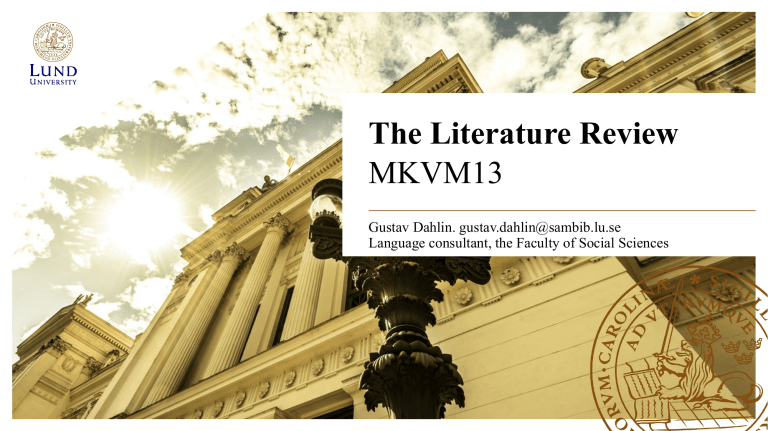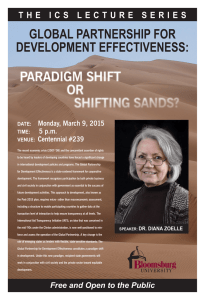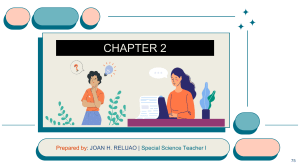
The Literature Review MKVM13 Gustav Dahlin. gustav.dahlin@sambib.lu.se Language consultant, the Faculty of Social Sciences Writing the literature review Today’s session • The nuts and bolts of the review • The language of the review • The structure and rhetorical steps of the review • Key sentences and free-writing • ONE-MINUTE PAPER Learning outcomes Writing the literature review Understand the purpose and aim behind the literature review in the context of a larger research paper Understand how the literature review is organized and structured Understand what features of language are used in the literature review in order to examine research, but also to accentuate your academic voice Design and construct the literature review independently on the basis of language and structure Writing the literature review WHAT is the literature review? WHY do we write the literature review? • An overview of the relevant research and/or theoretical and conceptual framework • To access the academic discourse of the subject matter • A directory to the subject matter under research • To identify gaps in the research • An examination of HOW the literature (in a broad way) is relevant to the research • To procure a background of the subject matter in order to discuss your own results in relation to prior research in the area • A piece of expository writing, i.e. outlining, comparing, contrasting and looking for patterns, reviewing, examining, analysing • To generate a perspective on your research. You should be activating readers’ expectations or curiosity • NOT a regurgitation of the literature Writing the literature review HOW do we write the literature review? • The review is the cornerstone of academic writing in that we aim to systematically classify themes, relations, theories, research results etc. in order to find patterns (that we use to analyse & interpret) • WE… – outline and describe the situation – elaborate & develop, present possible reasons (behind the issue), compare & contrast, analyse the issue etc. – reflect – and draw conclusions – in other words, we synthesize Reporting verbs Writing the literature review: Style & language • The growing importance of the transparency and control paradigm in application of personalized marketing communication is also reflected in academic research. The effects that data collection transparency has on users have been investigated (e.g., Aguirre et al., 2015; Kim et al., 2019) as have the ways in which control over data collection impacts users’ perceptions and behavior (e.g., Strycharz, van Noort, Smit, et al., 2019; Zarouali et al., 2018). Individual control over personal data has also been portrayed as a crucial element of privacy (Altman, 1975). However, the literature provides little consensus on how personalization transparency and control should be conceptualized. For example, while Aguirre and et al. (2015) call transparency “overt data collection” and focus on consumer awareness of data collection practices, Kim et al. (2019) write about “ad transparency” in terms of the disclosure of data collection practices. Similarly, control has been conceptualized as abilities users have to control data collection (Joo, 2018), but also as the desires that users have to exercise such control (Strycharz, van Noort, Smit, et al., 2019). Such substantial differences in conceptualizations impact the reliability and validity of the results and impede knowledge accumulation in the field. Therefore, the aim of the current study is to map academic research on personalization transparency and control and provide guidelines for future research on this issue. Writing the literature review: Style & language The language of the literature review •Reporting verbs • Others making claims – believe/suggest/argue/claim/assert/emphasize/maintain/insists • Others agreeing – acknowledge/agree/endorse/praise/admire/celebrate/reaffirm/support/verify • Others disagreeing or questioning – contend/contradict/complicate/question/deny/refute/reject/renounce • Others recommending – advocate/encourage/exhort/urge/recommend • The Academic Phrasebank – https://www.phrasebank.manchester.ac.uk/referring-to-sources/ Reporting verbs Writing the literature review: Style & language • Abercrombie and Longhurst outline two dominant paradigms in earlier studies of media audiences. The first paradigm concerns behavioural and effects based research. A behavioural paradigm uses quantitative and laboratory methods to research the effects of the media on audiences. Within effects studies, the focus is often on negative effects of violence, or pornography, on children and adults over short and longer periods of time. This paradigm has been criticised for its assumptions regarding the causal effect of media on passive audiences; criticisms include a media centric approach to audiences that considers individual behaviour rather than audiences within social contexts. The second paradigm stems from a direct critique of behaviourist research by the cultural studies scholar Stuart Hall and other researchers who established an active model of audiences in the 1970s. This critical approach to media and its encoded messages pays attention to interpretation and meaning, often using qualitative methods to analyse how people decode media in multiple ways, including the incorporation of, or resistance to, ideologically framed content by powerful institutions. Abercrombie and Longhurst recognise the significance of the incorportation/resistance paradigm within media and cultural studies research, for example regarding gender and audience research. However, they caution researchers to challenge assumptions regarding a message to receiver framework within this model. A third approach is the spectacle/performance paradigm that draws on ideas regarding diffuse and active audiences in late modern society. The authors build a complex argument about the crisis of identity in Western societies, where spectacle, narcissism and aestheticisation dominate modern media. They consider the ways in which the performance of identity has become entangled within media and our everyday lives. Within this paradigm, the authors argue for multiple methods, including qualitative and quantitative approaches from surveys to focus groups, or observations and participatory research, which can be used to critically examine varieties of audience experiences for cross media content in the context of everyday life. Writing the literature review: Style & language The language of the literature review • Signpost language • Addition – furthermore/in addition/indeed/moreover • Elaboration – actually/by extension/in short/in other words/ultimately • Signpost language • Referencing others – According to…/In X’s recent work…/In X’s work, it is…/What X argues for…/When it comes to…X… • Contrast – although/by contrast/however/nevertheless/on the contrary/whereas/while • Cause & effect – accordingly/hence/thus/therefore/as a result • Conclusion • Comparison – in the same way/likewise/similarly • Adding metacommentary – consequently/hence/thus/therefore – Although some might disagree, it does…/Ultimately, this means that…/In sum, then…/Incidentally…/To put it bluntly... Writing the literature review: Style & language Signpost language • Despite the obvious shortcomings of commercially defined digital profiling, it remains the case that sufficient scale confers numerical value to even the most clumsy survey instrument. In that respect, the global scale at which contemporary social media platforms operate is inconceivably vast (two billion is an abstract only tangible, perhaps, to a seasoned quant). Nobody has ever had so much data, nor had it in an individuated and relational structure so purposefully designed for correlation. Unlike an earlier era, where market researchers would examine consumers in direct relation to a given product, the vast datasets of the social media era are purposefully intended to automatically correlate past and potential behaviours in relation to all or any products, activities or actions. This constitutes something of a tipping point in the informational economy. It became possible only because processing power increased exponentially (as anticipated by Moore’s law). It became possible only because data storage became inconceivably vast and cheap. It became possible only because a user-led medium of record removed the need to employ millions of data entry clerks to capture the data. With this architecture in place, the engineers of Web 2.0 consciously initialised a chain reaction in the generation of data. The ultimate output of this vast experiment is a mode of informatics where particular logics of correlation can be deployed to create new knowledge from the raw material (see Zafarani et al., 2014). To further draw out the analogy between applied nuclear physics and informational physics, this is the point at which more energy is coming out of the process than is going into it. Writing the literature review: Style & language Task: Focus on verbs & signpost language Review the excerpt or a paragraph from an article of your own: - What verbs & signpost language can you identify? - What function do they have and how do they shape the text? OR Review your own writing: - How have you used signpost language in your review thus far? - How are verbs employed? - Can you detect stance and attitude in the way you use language? Is it appropriate? Writing the literature review: Style & language Task: Focus on verbs & signpost language The growing importance of the transparency and control paradigm in application of personalized marketing communication is also reflected in academic research. The effects that data collection transparency has on users have been investigated (e.g., Aguirre et al., 2015; Kim et al., 2019) as have the ways in which control over data collection impacts users’ perceptions and behavior (e.g., Strycharz, van Noort, Smit, et al., 2019; Zarouali et al., 2018). Individual control over personal data has also been portrayed as a crucial element of privacy (Altman, 1975). However, the literature provides little consensus on how personalization transparency and control should be conceptualized. For example, while Aguirre and et al. (2015) call transparency “overt data collection” and focus on consumer awareness of data collection practices, Kim et al. (2019) write about “ad transparency” in terms of the disclosure of data collection practices. Similarly, control has been conceptualized as abilities users have to control data collection (Joo, 2018), but also as the desires that users have to exercise such control (Strycharz, van Noort, Smit, et al., 2019). Such substantial differences in conceptualizations impact the reliability and validity of the results and impede knowledge accumulation in the field. Therefore, the aim of the current study is to map academic research on personalization transparency and control and provide guidelines for future research on this issue. Writing the literature review: Style & language Task: Focus on verbs & signpost language The growing importance of the transparency and control paradigm in application of personalized marketing communication is also reflected in academic research. The effects that data collection transparency has on users have been investigated (e.g., Aguirre et al., 2015; Kim et al., 2019) as have the ways in which control over data collection impacts users’ perceptions and behavior (e.g., Strycharz, van Noort, Smit, et al., 2019; Zarouali et al., 2018). Individual control over personal data has also been portrayed as a crucial element of privacy (Altman, 1975). However, the literature provides little consensus on how personalization transparency and control should be conceptualized. For example, while Aguirre and et al. (2015) call transparency “overt data collection” and focus on consumer awareness of data collection practices, Kim et al. (2019) write about “ad transparency” in terms of the disclosure of data collection practices. Similarly, control has been conceptualized as abilities users have to control data collection (Joo, 2018), but also as the desires that users have to exercise such control (Strycharz, van Noort, Smit, et al., 2019). Such substantial differences in conceptualizations impact the reliability and validity of the results and impede knowledge accumulation in the field. Therefore, the aim of the current study is to map academic research on personalization transparency and control and provide guidelines for future research on this issue. Writing the literature review: Style & language The literature review: “Studies indicate that…” • In academic writing, we engage in a conversation with ”others” (the academic discourse) and therefore we need summarize, paraphrase and quote what “the others say” – especially so in the literature review • How do we summarize, paraphrase and quote effectively? – Balance what the original authors says with our perspective/focus by… – identifying the key points & arguments of a sentence/passage/section/article/theoretical framework, and inferring its relevance to our perspective Writing the literature review: Style & language Summarising, paraphrasing, or quoting…? • TASK: What is the difference between summarising, paraphrasing and quoting? • While paraphrasing could be said to be a form of summary, it is a re-write of a passage. Summaries, on the other hand, encapsulate the content of articles, books, theories belief systems etc. • When paraphrasing, it is crucial that we internalise the content and re-write it into your words – and not just restructure the sentence. This could potentially lead to PLAGIARISM • When we quote, we use the authors’ words verbatim, i.e. word by word. Quotes are punctuated in quotation marks, and ideally merged into the structure of our sentence (unless a longer quote) Writing the literature review: Style & language How to paraphrase and summarize • We use reporting verbs, signpost language and syntax to summarize and paraphrase. – Verbs that encapsulate the bigger picture of what we, as writers, infer from the text (X’s research suggests, Y argues that, Y’s study suggests…) – Signpost language to convey our perspective – or at least our perspective on the research – onto the reference (Indeed, X’s results highlight the importance of…In contrast, Y’s study shows how…) – Syntactical structures help for example juxtapose and look for patterns (While X argues….Y maintains…/Although X contends that…At the same time as X’s perspective presents…Y’s research is indicative of…) Writing the literature review: Style & language Verbatim • When we quote, we should make use of the existing grammatical structure in order to merge the quote into the same structure (unless it is a longer quote). Ideally, look for verbs and nouns. – Instead we must face the 'challenges of transnationalism and the politics of global capitalism or multiple overlapping and conflicting juridiscapes’ (J Coombe, 2000). – Cammett argues that both sectarianism and service provision create the conditions for inclusion or exclusion of groups and ‘illuminates the political geography of sectarianism’ (p. 217). Writing the literature review: Style & language TASK: In practice 1. Skim-read a passage from one of the articles you intend to use 2. Re-read, and highlight key words and key sentences 3. Write a summary 4. Paraphrase a smaller passage and include a direct quote THE STRUCTURE How do you structure a literature review? Writing the literature review: Structure The structure of the literature review •Paragraph – Summary/Synthesis of issue in KS – Outlining the issue – Examination Writing the literature review: Structure Rhetorical structure • How do you structure expository texts, i.e. reviews? 1. 2. 3. 4. A KS encapsulating the issue (e.g. a theoretical framework, a perspective, what X has found about Y etc.). If the review takes a comparative/contrasting perspective, the structure of the sentence should reflect the same. This part synthesizes the source information. Supporting sentences that explain and clarify, but more importantly, map out patterns, connect, compare or juxtapose. This part describes the source information. It must be considered in light of the focus of your research. In other words, you analyze and critically evaluate what has been mapped out, compared or juxtaposed. This the part examines the source information. A final KS that encapsulates the issue considering your specific project. So, a conclusion of sort (on a textual as well as paragraph level). A final examination. Writing the literature review: Style & language The growing importance of the transparency and control paradigm in application of personalized marketing communication is also reflected in academic research. The effects that data collection transparency has on users have been investigated (e.g., Aguirre et al., 2015; Kim et al., 2019) as have the ways in which control over data collection impacts users’ perceptions and behavior (e.g., Strycharz, van Noort, Smit, et al., 2019; Zarouali et al., 2018). Individual control over personal data has also been portrayed as a crucial element of privacy (Altman, 1975). However, the literature provides little consensus on how personalization transparency and control should be conceptualized. For example, while Aguirre and et al. (2015) call transparency “overt data collection” and focus on consumer awareness of data collection practices, Kim et al. (2019) write about “ad transparency” in terms of the disclosure of data collection practices. Similarly, control has been conceptualized as abilities users have to control data collection (Joo, 2018), but also as the desires that users have to exercise such control (Strycharz, van Noort, Smit, et al., 2019). Such substantial differences in conceptualizations impact the reliability and validity of the results and impede knowledge accumulation in the field. Therefore, the aim of the current study is to map academic research on personalization transparency and control and provide guidelines for future research on this issue. Writing the literature review: Structure Task: Writing your key sentence This task aims at synthesizing a larger piece of text, e.g. a theory, specific research result. Consider therefore also direct quotes and paraphrasing. – Take the article that you chose for today’s workshop – If the idea is broad, summarize it in no more than three sentences – Consider whether you are aiming at comparing, juxtaposing, looking for a pattern etc. with your sentence – What is your stance/perspective? Choose a verb accordingly (e.g. suggest, claim, argue, maintain) – As you begin phrasing the sentence, think about signpost language, but also syntax Writing the literature review: Structure What is free-writing? A method of writing out your thoughts A method of writing that helps develop ideas A way to write out vague thinking, abstractions and complex concepts to oneself Creative thinking in writing Free-writing is “free”, in terms of form. Task: Free-write supporting sentences This task aims at completing the paragraph, but for your eyes only. In other words, it works to develop ideas. – Go back to your KS, and begin expanding on it by adding supporting sentences. – If your KS conveys, for example, a comparative perspective, your supporting sentences should reflect that A friendly reminder • The Academic Support Centre – https://www.lunduniversity.lu.se/current-students/academic-matters-andsupport/academic-support-centre – Visiting address: Genetikhuset, rooms 219–222 Sölvegatan 29B, Lund Academic Support Centre on Google Maps • Book a consultation: https://www.timecenter.se/studieverkstaden/ • Lectures at the Academic Support Centre – https://www.lunduniversity.lu.se/current-students/academic-matters-andsupport/academic-support-centre/lectures-academic-supportcentre#reading-strategies Thank you for listening – and participating!







